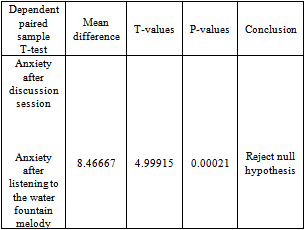-
Paper Information
- Next Paper
- Previous Paper
- Paper Submission
-
Journal Information
- About This Journal
- Editorial Board
- Current Issue
- Archive
- Author Guidelines
- Contact Us
American Journal of Sociological Research
p-ISSN: 2166-5443 e-ISSN: 2166-5451
2012; 2(4): 78-81
doi: 10.5923/j.sociology.20120204.04
Evaluation of the Effect of Preoperative Natural Water Fountain Melody on Teenagers’ Behavior- Preliminary Study
Abd El Aziz A. N 1, K. Jahangir. 1, Kobayashi Y. 2, F. Norliyana 1, Ahmad Jamil A. 1
1Advanced Medical and Dental Institute, University Sains Malaysia
2Center of Policy and International Studies, University Sains Malaysia
Correspondence to: Abd El Aziz A. N , Advanced Medical and Dental Institute, University Sains Malaysia.
| Email: |  |
Copyright © 2012 Scientific & Academic Publishing. All Rights Reserved.
Dental treatment is painful and scary. Previous negative experienced may trigger internal conflicts such as tension, discomfort and distress that could lead to systematic complications. Objective: The present study aims to clarify the effects of natural water fountain melodies on Teenagers’ behaviors before Dental checkup. Methods: 30 subjects, age 12-16 years old Consented volunteers were randomly assigned to five groups; four experimental groups which received four different types of natural water fountain melodies and one control group which did not receive any intervention. Participants in each group were asked to complete State Trait Anxiety Inventory (STAI, bilingual version) with no time restriction before undergoing dental checkup and after water fountain melody intervention. The results: the study results demonstrated that STAI, scores (M=41. 40, SD=10. 84) decrease after the subjects listening to the water fountain melody before dental checkup (M= 32.93, SD=9. 42). Also the scores decrease on comparing the experimental groups (M=31. 00, SD=1. 46) in the control group with no melody intervention (M=40. 67, SD=5. 60). Conclusion: Decrease of STAI scores indicates reduction of the subject’s anxiety. The results of this study indicated that natural water fountain melodies are useful for the anxiety management.
Keywords: Natural Water Fountain, Teenagers, Behaviors, State Trait Anxiety Inventory
Cite this paper: Abd El Aziz A. N , K. Jahangir. , Kobayashi Y. , F. Norliyana , Ahmad Jamil A. , "Evaluation of the Effect of Preoperative Natural Water Fountain Melody on Teenagers’ Behavior- Preliminary Study", American Journal of Sociological Research, Vol. 2 No. 4, 2012, pp. 78-81. doi: 10.5923/j.sociology.20120204.04.
Article Outline
1. Introduction
- Dental clinic attendance is important behavior that should encourage in early child development since it has a clear positive association with dental health. As defined by the World Health Organization (WHO)[1], oral health means being free of chronic mouth and facial pain, oral and throat cancer, oral sores, birth defects such as cleft lip and palate, periodontal diseases, tooth decay and tooth loss, and other diseases and disorders that affect the mouth and oral cavity. However referring to the National Health Epidemiology Study (NOSHH) in 2007, approximately 74.5% Malaysian children age from 6 years old suffered oral problems. Thus, it is still considered as serious phenomena in the promoting dental hygiene as only 25.5% Malaysian children are free from dental problems; far behind WHO estimation which target 50% of children around the world should meet the dental health global standards. Dental anxiety is a major reason for patient avoidance of dental care which positively related to dental clinic attendance[2]. For most dental patients especially teenagers, dental treatment are painful and scary. Previous negative experienced may trigger internal conflicts such as tension, discomfort and distress that could lead to systematic complications. The most significant factors behind the dental fear among teenagers are patient’s beliefs and recalled negative experiences such as anticipatory anxiety and fear association with specific dental stimuli during dental treatment[3]. Listening to relaxing music during root canal treatment decreased the stress level of patients[4]. Based on existing literatures, it can be inferred that music can be considered as a therapeutic intervention in maintaining individual’s positive emotional outcomes. Numerous studies are being conducted on the value of water sounds as a therapy for various psychological treatments[5]. State Trait Anxiety Inventory (STAI) was used to further investigate the volunteer’s emotional condition[6].Research’ team expected that Volunteers will score lower in State Trait Anxiety Inventory (STAI) after listened to the Water Fountain melody and experimental groups will score lower in STAI as compared to the control group after listened to Water Fountain Melodies.
2. Objectives
- 1. To examine anxiety levels among the volunteers before and after melody intervention. 2. To investigate whether Water Fountain melodies could decrease anxiety levels among the volunteers before undergoing dental checkup.3. To compare the effects of Water Fountain Melodies between Experimental groups and Control group
3. Methodologies
- Volunteers age 12-16 years old were selected fulfill all the inclusions and exclusive criteria.Inclusion criteria:a. No previous anxious dental experience b. Have no dentin sensitivity to air stimulation. c. No hearing problem Exclusion criteria:a. If in a serious debilitating oral disease (acute periodontal pain, pulpits, abscess, or otheracute infections, attachment loss or gingival recession, root hypersensitivity that mightcause tooth hypersensitivity.b. Patients with severe anxiety and non-cooperative c. Not interested in music d. Having medical or psychological disorder that might affect pain thresholdse. Using pain or anxiety medication Upon completing the inform consent, researchers had explained briefly about the experimental procedure to the volunteers. Consented volunteers were randomly assigned to Experimental group and Control group. Prior to the study, participants in each group underwent discussion session to make them more serious for the experiment and then asked to complete a self-rated questionnaire on their emotional regulation, State Trait Anxiety Inventory (STAI, bilingual version) (7), with no time restriction before and after the natural water fountain melody intervention for 10 minutes for the experimental group. The subjects in the control group were also used Mp3 for 10 minutes but with no music melody. After that, the volunteers were instructed to proceed to the dental room for checkup session.
4. Results
 | Figure 1. Normal probability plot Level of Anxiety after Discussion Sessions |
 | Figure 2. Normal probability plot Level of Anxiety after Listening Water Fountain’s Melody Sessions |
|
|
|
5. Discussions
- State-Trait Anxiety Inventory (STAI) in brief, it clearly differentiates between the temporary condition of state anxiety’ and the more general and long-standing quality of individual trait anxiety’[7]. STAI scores range from 20 to 80, higher scores are positively correlated with greater anxietylevel.Based on a psychophysiological theory synthesized from the literature, certain type of music induces relaxation and pleasure responses, which reduces activity in the neuroendocrine and sympathetic nervous systems; this result in decreasing anxiety, heart rate and respiratory rate.Intervention of natural water fountain melodies before the dental checkup in the experimental group reduce teenagers worries and anxiety, thereby illustrate lower STAI scores as compared to the control group with no melody. There was a significant difference in anxiety scores. This finding is similar to the results of studies reported that soothing music lowered subjects’ anxiety[8].It can be assured that natural water fountain melodies might help volunteers to elicit the relaxation response by activating nervous systems while reducing heart rate and lowering blood pressure, at the same time recuperating body and mind towards resting mode with similar effects as soothing music[9].The findings provide evidence for nurses and dentists to use the natural water fountain melodies for anxiety reduction with dental patients undergoing a dental checkup procedure which is supported by the researchers.
6. Conclusions
- Fear of dental treatment is a major reason for patient avoidance of dental care. The healing aspects of nature sounds therapy including water sound are beginning to get a lot of interest in the medical fields. Analysis of STAI collected data showed thatnatural water fountain music administered through Mp3 to teenagers before dental checkup decreased the procedure-related anxiety of the patients’ signs. Volunteers scored lower in State Trait Anxiety Inventory (STAI) after listening to the Water Fountain melody. Based on the current findings, it could be inferred that natural water fountain melodies are one of useful methods for practical dental settings especially in promoting positive anxiety management among youngster patients. Thus, it is hoped that natural water fountain melodies could possibly serve as preventative medicine to create ‘feels good’ dental clinic attendance among the dental community in the long run term. Also Further researches need to be done in this field using other techniques and newer strategies should be devised to manage anxious pediatric dental patient.
References
| [1] | World Health Organization: Media Centre. (N.d). Retrieved on 14/3/2012 fromhttp://www.who.int/mediacentre/factsheets/fs 318/en/. |
| [2] | Skaret, E.,Raadal, M.,Kvale, G.,& Berg, E. 1999. Dental anxiety and dental avoidance among 12–18-year olds in Norway. European Journal of Oral Sciences 107: 422 - 428. |
| [3] | Racine, R. 2004. Dental fears among teenagers: Individual anxiety factors. Stomatolog Baltic Dent Maxillofac J 6: 118-121. |
| [4] | Li, H.I., Hwang, M. J., Chen, C J., Chang, K. F., Peng, T. C., & Chang, F. M. 2008. Randomized controlled trial of music on state anxiety and physiological indices in patients undergoing root canal treatment. Journal Clinical Nursing 17: 2654 - 2660. |
| [5] | Ross Shilawani, S. A. K., Azlan Hakimi, Y. R., Husna, A. R., Mohd Nasir, T., Zunairah, M.,& Sahrim, L.2009. Analysis of correlation between body mass index (BMI) and brain wave using EEG for alpha and beta frequency band. Paper presented at the 5th Colloquium on Signal Processing and Its Applications (CSPA). |
| [6] | Tilton, S. R. 2008. Review of state trait anxiety inventory (STAI). NewsNotes 48 (2). |
| [7] | Spielberger, C. D. 1983. Manual for the State-Trait Anxiety Inventory (STAI). Palo Alto, CA: Consulting Psychologists Press. |
| [8] | Chang, Y. M., Peter. W. H. L., Ng. T. Y., Hextan, Y. S. N., & Wong. L. 2003. C. The use of music to reduce anxiety for patients undergoing colposcopy: A randomized trial. Gynecologic Oncology 91: 213-217. |
| [9] | White, J. 1992. Music therapy: an intervention to reduce anxiety in the myocardial infarction patient. Wisconsin Medical Journal; 90: 434 - 437. |
 Abstract
Abstract Reference
Reference Full-Text PDF
Full-Text PDF Full-Text HTML
Full-Text HTML